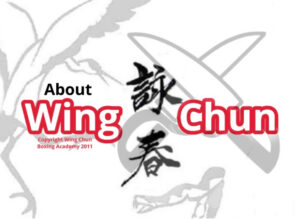Wing Chun is a time-tested system of self-defense that has been described as a “back alley, bar room fighting style.” Wing Chun is not a sport or exhibition style. From its conception, Wing Chun has always been an ever-evolving system of self-defense, fighting skills and defensive tactics. Wing Chun is noted for its brutal efficiency and has been taught and integrated into hundreds of military and law enforcement agencies training programs such as the US Navy Seals, US Army Special Forces, the FBI, SWAT teams as well as forming a foundation for Rapid Assault Tactics or R.A.T. Fight by Paul Vunak.
Here is a quote from Paul Vunak’s R.A.T. FIGHT, Combat Secrets of the World’s Deadliest Fighters, (pg. 26) “The art of Wing Chun was developed by a woman, no doubt smaller and not as strong as her male counterparts. The underlying premise of using Wing Chun is that you are fighting a bigger, stronger opponent. Trading kicks and punches is clearly not the ideal strategy.”
Wing Chun is the art for anyone who desires to learn how to mitigate the size differential and win.
Our Training Methodology:
We use a step-by-step approach. First, we teach the student the purpose of anything martial which forms the core of Wing Chun’s theories and applications. The second stage of training involves the student drilling the various applications of the system as we hone the execution and advance the student’s knowledge and skills. At the final stage of training, we train the applications on a non-compliant partner to test one’s understanding & skill of the system..
Students are also cross trained in Filipino Escrima/ Kali to develop their understanding and skills with weapons early in their training.
Misconceptions About the Style: A couple of misconceptions about Wing Chun are that there are no kicks or ground fighting techniques in the style. Wing Chun has 8 major kicks that seek to devastate an opponent while never kicking above the waist. It is said in Wing Chun that “Wing Chun does not have kicks; it has leg breaks.”
Ground fighting is also an integral part but it is taught later in the system because Wing Chun espouses the idea that being less mobile could lead to more damage and that defeats the idea of avoiding getting hit or hurt as you counter attack.
Wing Chun is the only fighting art that Bruce Lee ever formally studied. It is the skills that he learned in Wing Chun that catapulted him to stardom in the martial arts world. Wing Chun formed the core of his Jun Fan/Jeet Kune Do. He stated on several occasions after creating JKD that he would use Wing Chun (NOT Jeet Kune Do) if he were in a fight for his life.
His teacher was Master Yip Man. He introduced Duncan S.H. Leung to Yip Man and Wing Chun as a fighting art because they were childhood friends. Master Yip Man taught Duncan S.H. Leung as a closed door student and formal disciple. Master Leung’s line is continued by SiFu Dustan Carroll, who was trained as a formal disciple and closed door student of a former disciple of SiFu Dave Meadows who was a disciple under Master Duncan Leung.
An Article From Martialdevelopement.com
Robbie Lawler’s Ruthless Wing Chun
Tags: EliteXC, MMA (Mixed Martial Arts), rules, self-defense, Wing Chun
I’ve always known that, sooner or later, the Chinese art of Wing Chun Kuen would be represented in a professional mixed martial arts bout. I just didn’t expect to see it in MMA’s historic prime-time debut.

Robbie Lawler
On May 31, 2008, “Ruthless” Robbie Lawler forever settled any reasonable doubts about Wing Chun’s viability in real combat. And he did it by accident.
Robbie Lawler faced Scott “Hands of Steel” Smith in the inaugural broadcast of CBS’ Saturday Night Fights. During the first two rounds of this title bout, both men fought according to New Jersey’s Unified Rules of Mixed Martial Arts: no headbutts, biting, groin attacks, or rabbit punches; no hair-pulling or small joint manipulation; no fish-hooking or strikes to the trachea.
For more than ten minutes, Lawler and Smith used their training in boxing, Muay Thai, wrestling and BJJ to soften each other up. Neither fighter held a clear advantage, and so the exchange continued. Then “Ruthless” Lawler stuck his fingers in Smith’s eye.
Referee Dan Miragliotta halted the fight immediately. Scott “Hands of Steel” Smith hoped to continue after a five-minute rest to regain his vision, but the doctor forbid it. The match was called: no contest.
Lawler’s eye poke, unintentional though it was, ended the bout in seconds. There is little doubt in my mind that, if the referee had allowed it, Lawler could have followed up with an uncontested knockout.

Robbie Lawler fingers Scott Smith in round 3
Ring Fighting vs. Real-World Self-Defense
As a professional fighter, Scott Smith followed the match rules, and he was reasonable to assume that Robbie Lawler would do the same. However, it would also be reasonable to assume that, in a five-round fight with fingerless gloves, a stray finger could land in your eye, and to defend against such an accident.
If only such a thing were possible. The eyes are the most sensitive area on the body, and especially difficult to protect. If the opponent can so much as touch your eyes, they can damage them permanently, so the threat demands a conservative game. (The same principle applies, to a lesser degree, to defending the throat and genitals.)
Effective defense of vital areas cannot be an afterthought; it must be integrated into a fighting strategy from the outset, and supported by coherent tactics. The approach must be conservative, but also vicious, in order to eliminate the threat as rapidly as possible.
Does any of this sound familiar? These are the precepts of Wing Chun Kuen, Bruce Lee’s original martial art. Wing Chun starts where MMA ends; it is brutal and direct. Rules, community standards, and basic human decency prevent it from being fully applied in the competitive arena, but as Robbie Lawler reminded us yesterday, the ruthless hands of Wing Chun should not be discounted.
Old School Martial Arts Training That Works
*We reserve the right to choose
our students
Devastatingly Useful Combative Knowledge & Skills™

